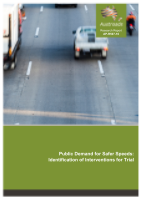Road Safety

- Publication no: AP-R507-16
- ISBN: 978-1-925294-97-2
- Published: 10 February 2016
- PDF (free) Download
Speeding is a major contributor to road injuries and fatalities and remains prevalent. Changing community perceptions about speeding is an important priority.
Austroads commissioned research to identify a range of potential interventions for future trial and evaluation aimed at creating, increasing, and/or sustaining public demand for safer speeds. This project had three phases: a literature review; consultations with key stakeholders regarding intervention options (including feasibility, and likely benefits and costs of identified interventions); and providing research results, including recommendations for future phases of the program of work.
The literature review led to the development of a draft Campaign Strategy targeting nine aims across three themes underpinning this research: 1) creating, 2) increasing, and 3) sustaining public demand for safer speeds on the road. Twenty-one stakeholders commented on the suitability and feasibility of, and likely barriers to, countermeasures within the draft Campaign Strategy and its applicability to the Australian and New Zealand context. There was overwhelming positive support for the proposed Campaign Strategy by the majority of respondents; many, noting that it addressed key misperceptions and complemented many existing approaches. A small number of respondents expressed some concerns with various aspects. Stakeholder feedback was incorporated into the final proposed Campaign Strategy to enhance its potential effectiveness.
Wide diversity across jurisdictions makes the recommendation of individual interventions for specific areas problematic. Individual jurisdictions should consider a range of costs and benefits of the proposed Campaign Strategy to determine the likely feasibility from their unique perspective. Issues to be addressed when considering implementation of the proposed Campaign Strategy include speed limit setting policies, resourcing, messaging and advertising strategies, and political will associated with promoting safer speeds.
- Summary
- 1. Introduction
- 1.1. Safe Speeds as part of a Safe System
- 1.2. Project scope
- 1.3. Methodology
- 1.4. Structure of the review
- 2. Overview of speeding as it relates to road safety
- 2.1. Relationship between vehicle speed and crash risk and severity
- 2.2. Prevalence of speeding
- 2.3. Factors influencing speeding behaviour
- 2.3.1. Personal factors
- 2.3.2. Legal factors
- 2.3.3. Situational factors
- 2.3.4. Social factors
- 2.3.5. Implementation intentions and pledges to counter speeding
- 2.4. Community beliefs and attitudes towards speeding
- 2.4.1. Roadwork zones
- 2.4.2. School zones
- 2.4.3. Community attitudes towards speed management initiatives more broadly
- 2.5. Perceptions of ‘safer speeds’
- 2.6. The role of theory in behaviour change
- 3. Creating demand for behavioural and social change – lessons from previous successes
- 3.1. Case study 1: smoking behaviour
- 3.1.1. Evidence-based research
- 3.1.2. Legislation – tobacco legislation and taxation
- 3.1.3. Public education, advertising and mass media campaigns
- 3.2. Case study 2: drink driving
- 3.2.1. Evidence-based research
- 3.2.2. Legislation
- 3.2.3. Public education, advertising and mass media campaigns
- 3.3. Case study 3: seat belt use
- 3.3.1. Evidence-based research
- 3.3.2. Legislation
- 3.3.3. Public education, advertising and mass media campaigns
- 3.4. Speeding
- 3.4.1. Evidence-based research
- 3.4.2. Legislation
- 3.4.3. Public education, advertisement, and mass media campaigns
- 4. Interventions previously used for creating, increasing or sustaining demand for safer speeds
- 4.1. Public education strategies
- 4.1.1. Mass media and advertising campaigns
- 4.2. Community-based behaviour change initiatives
- 4.2.1. Speed limit reduction initiatives
- 4.2.2. Holistic approaches (active transportation and eco driving)
- 4.2.3. Incentive/rewards schemes
- 4.2.4. Gamification and mobile phone applications
- 4.2.5. Community-based programs targeted at specific groups
- 4.3. Intelligent transportation systems
- 4.3.1. Intelligent speed adaptation (ISA)
- 4.3.2. Dynamic vehicle-activated signs
- 4.4. Enforcement
- 4.4.1. Effectiveness of police speed enforcement
- 4.4.2. Innovative approaches to speed enforcement
- 4.4.3. Enforcement tolerances
- 4.4.4. Accompanying communication strategies
- 5. Considerations for potential countermeasures
- 5.1. Road safety advertising
- 5.2. Community-based behaviour change initiatives
- 5.3. Intelligent transportation systems
- 5.3.1. Intelligent speed adaptation (ISA)
- 5.3.2. Dynamic vehicle-activated signs
- 5.3.3. Enforcement-related issues
- 5.4. Changing the conversation about speeding to help change public perception about speeding
- 5.5. Summary
- 6. Stakeholder consultations
- 6.1. Method
- 6.1.1. Participants
- 6.1.2. Online questionnaire
- 6.2. Results
- 6.2.1. Support for the Campaign Strategy
- 6.2.2. Broadening the Campaign Strategy
- 6.2.3. Campaign Strategy (or parts) lacking support
- 6.2.4. Political will is crucial to success
- 6.2.5. Feasibility of the Campaign Strategy
- 6.2.6. Barriers to the Campaign Strategy
- 6.2.7. Other considerations
- 6.2.8. Additional ideas
- 6.3. Conclusions and recommendations
- 6.3.1. Considerations for individual jurisdictions
- 6.3.2. Implementation considerations
- References
- Appendix A Databases and key search terms
- A.1 Databases
- A.2 Search terms
- Appendix B Smoking – an historical overview of legislation and campaigns
- Appendix C Drink driving – an historical overview of legislation and campaigns
- Appendix D Seat belts – an historical overview of legislation and campaigns
- Appendix E Speeding – an historical overview of legislation and campaigns
- Appendix F Overview of example mass media and social marketing campaigns
- Appendix G List of respondent organisations
- Appendix H Road safety expert stakeholder questionnaire
- Appendix I Advertising/ behaviour change expert stakeholder questionnaire
